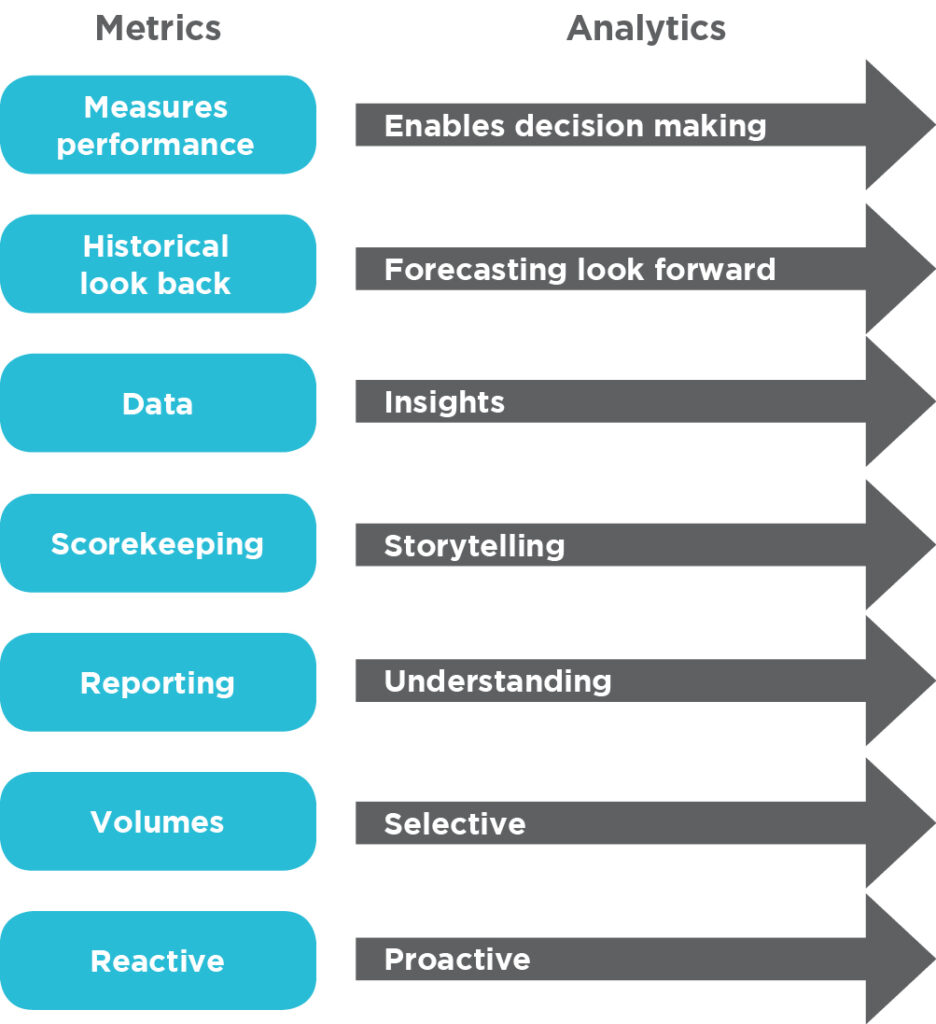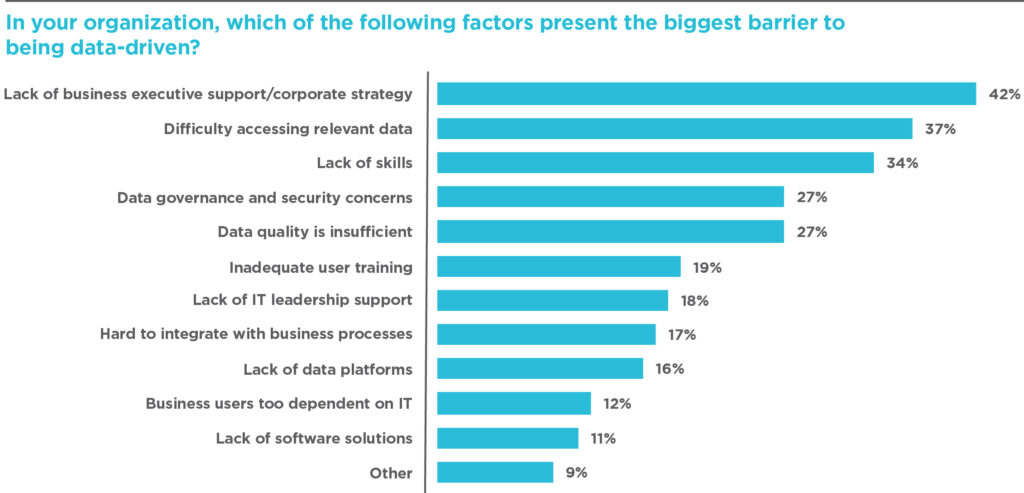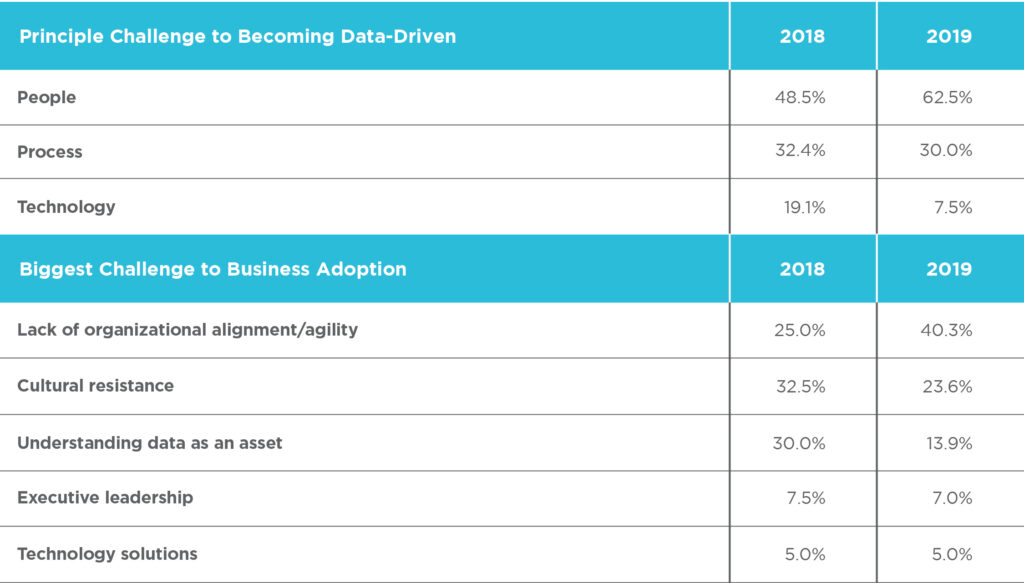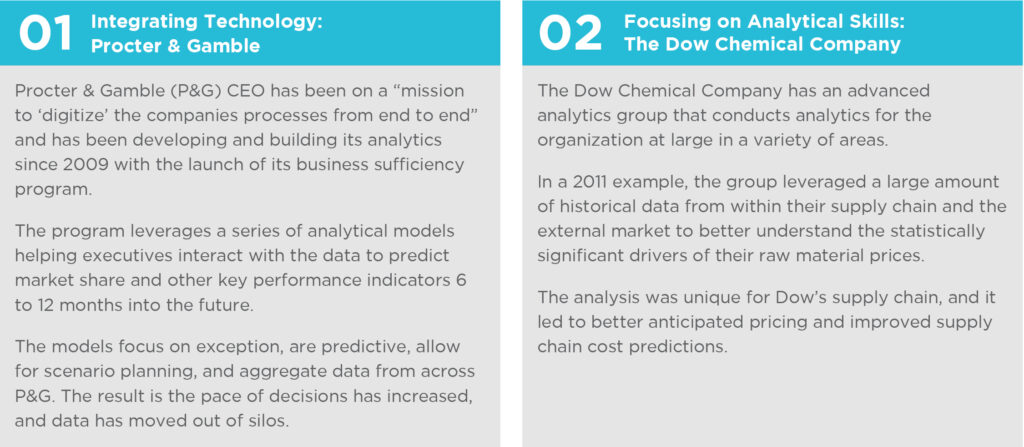
Business analytics and its potential value to organizations have been a frequent topic of discussion across industries over the last several years. Organizations have spent significant time and money installing and stabilizing Enterprise Resource Planning (ERP) systems, data warehouses, and Business Intelligence (BI) tools in an effort to more accurately capture operational data and use it to predict future business performance. The age of social media has spawned a whole new focus on “unstructured data” and how to analyze such information, while advances in digital and mobile technology have allowed us to collect data for almost anything.
As a result, companies are finding themselves awash in data—about their employees’ skills sets and experiences, customers’ preferences and habits, supply chain throughput and costs, and industry and market trends, etc. With this availability of data has come the obvious question— what should we do with all this information and how do we use it to our advantage?
ScottMadden believes that business analytics is here to stay. Organizations have come to realize that tools exist to make fact-based decisions with less reliance on “gut” instincts. Predictive analytic techniques combined with real-time data updates enable dynamic decision-making, and companies have accepted that this has real value. However, inherent struggles remain from bridging the gap between where most organizations are today to the efficient world of tomorrow where such business analytics are in place. Organizations have bought into the concept, but many are still unsure how to “make it happen” for them.
While the topic of business analytics has been around for some time, only a few companies have been able to take advantage of analytics and see its benefits. This lack of adoption is indicative of the level of effort required to achieve the benefits and of the fact that this space is still an emerging capability. Companies are becoming aware of the data available to them, but have yet to turn the corner in determining how to proactively use it to manage their business. To reach the desired end state often requires investment in expensive technologies, a focus on data integration of current information, and active recruiting and development of specialized knowledge and skills in the employee base.
SAS, a leader in BI and predictive analysis tools, previously defined analytics as “a wide range of techniques and processes for collecting, classifying, and interpreting data to reveal patterns, forecasts, anomalies, key variables, and relationships. The goal is to derive new insights that drive better decisions and more effective operational processes.”
More simply put, ScottMadden believes analytics defines the process by which we attempt to bridge the gap between knowledge (data) and action, and how we seek to ensure future actions reflect these data-driven insights. Analytics is not simply capturing the monitoring of metrics; it focuses on driving insight and action from past, and even current, behaviors and information.
Analytics help us (1) discover what has changed, (2) anticipate what will change, and (3) become more proactive making business operations decisions. For example, in the retail industry, sifting through historical purchasing data and social media buzz (via Twitter trending and Facebook likes) allows an organization to anticipate that a historically hot product is about to lose interest.

They can then quickly use this information to change their shelving plans for the product, replacing it with a new “up-and coming” product and communicate to their suppliers to cut back on overall production. As detailed in this example, the use of analytics enables organizations to get ahead of the game by giving executives the ability to make sound business decisions more quickly.
Analytics isn’t simply a buzzword—a multitude of studies show that organizations are investing, or planning to invest, in developing their analytical capabilities. Companies are starting to realize the competitive advantage that exists with analytics. The organizations that have been early adopters confirm the belief that analytics give them a competitive advantage and allow them to be more nimble in the marketplace.
According to APQC’s 2019 Trends in Data and Analytics survey, 73% of organizations increased their investment in data and analytics over the past three years. 42% of organizations have an independent, standalone department to manage analytics programs. 56% of organizations consider their data and analytics program to be effective or very effective. The 2018 Data & Analytics Global Executive Study and Research Report by MIT Sloan Management Review finds that more than half (59%) of managers say their company is using analytics to gain a competitive advantage. Organizations that demonstrate higher levels of analytical maturity saw a marked advantage in their customer relationships. The most analytically mature organizations are twice as likely to report strong customer engagement as the least analytically mature organizations. The analytics arms race may have begun, and if organizations are not using analytics to support business decisions, some data suggest they may ultimately lose their competitive edge.
The case for analytics is further supported by the growth in data available to companies. IDC predicts that the collective sum of the world’s data will grow from 33 zettabytes in 2019 to a 175ZB by 2025, for a compounded annual growth rate of 61%. Installation of ERP, Customer Relationship Management (CRM), and BI tools has increased the available data and provided a giant statistical sample for enterprises to mine and analyze. However, while organizations anticipate their data volumes to grow, the majority is not yet certain how they will manage such large amounts of data, nor whether they can distill key insights from such data in the speed necessary to inform business decisions.
Unfortunately, challenges continue to exist for companies trying to leverage data and incorporate analytics into their strategic and operational decision making. From ScottMadden’s perspective, the two biggest challenges facing organizations today reside in the integration of technology and the changing demands on their talent pool that analytics demands. Poor data literacy, culture challenges to accept change, and lack of relevant skills or staff are the biggest internal roadblocks to success and business growth, as ranked by respondents to Gartner’s third annual CDO survey. According to TDWI, barriers to improving the use of data and analytics to drive decisions include executive support, difficulty accessing and integrating all relevant data, lack of skills to build out BI/analytics, insufficient data quality, and data governance and security concerns.
Data integration is critical because it affects both the quality and the speed by which data can be assimilated, analyzed, and digested. It helps drive the cross-functional views and enables a better understanding of the overall business. However, integration by itself is not the only issue. Knowing how to use and translate data into insight and action is one of the biggest hurdles facing companies on their path to leveraging predictive analytics. According to Gartner’s A Data and Analytics Leader’s Guide to Data Literacy report, an information language barrier exists within majority organizations, rooted in ineffective communication across a wide range of diverse stakeholders. As a result, data and analytics leaders struggle to get their message across and information assets are underutilized.
This lack of analytics skill sets is forcing companies to recruit differently and reskill their resources, as well as creating specialized departments to focus on such recruitment and development activities. Gartner predicts that, by 2020, 50% of organizations will lack sufficient AI and data skills to achieve business value. NewVantage Partners’ 2019 Big Data and AI Executive Survey shows that 95% of business analytics adoption challenges are attributable to people and organization issues. This needs to change if they want to stay competitive. Data transformation is forcing companies to change who they are staffing in corporate roles—analytical mindsets and a focus on insight generation and storytelling are becoming a premium.


However, if organizations are willing to focus their efforts on overcoming these obstacles, the end state so often described is not an unrealistic outcome. As the three examples below show, companies are integrating technologies and pooling resources together to help bring insight and drive value through the use of analytics. Such investments can pay off if the appropriate investments are made.

The investments in technology and talent that companies need to make to achieve the benefits of business analytics are not insignificant. However, as shown by several companies already leveraging business analytics, the value of such analysis can provide a competitive advantage. The key question for organizations now is how to make the necessary technology and talent investments work best for them in order to help position themselves competitively. ScottMadden believes the pursuit of, and need for, expensive technologies and specialized skills leads to sharing analytical services across corporate functions. In many ways, shared services may provide the best vehicle to overcome the biggest obstacles facing a company’s goal of implementing business analytics. For more detail on shared services’ role in business analytics, please read ScottMadden’s paper titled “Business Analytics: The Next Wave of Value for Shared Services.”
View More View Accessible VersionSussex Economic Advisors is now part of ScottMadden. We invite you to learn more about our expanded firm. Please use the Contact Us form to request additional information.